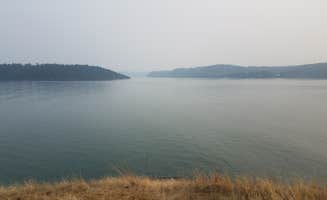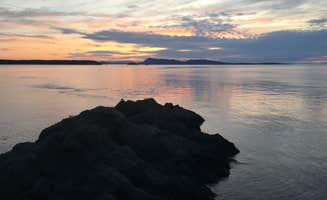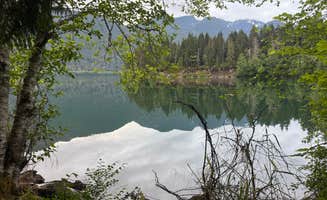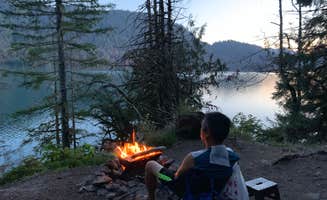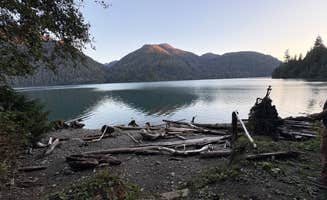Dispersed camping near La Conner, Washington centers primarily around mountain and waterfront locations requiring specific permits and vehicle capabilities. The Baker Lake area offers multiple free camping options along unpaved forest roads with elevation ranges from 700 to 1,500 feet. Most sites become inaccessible during winter months due to snow conditions, with optimal camping season running May through October when temperatures range from 45-75°F.
What to do
Paddle to island campsites: Hope Island Marine State Park requires careful water navigation and tide monitoring. "We kayaked to the island, the waters were pretty rough so I would recommend for anyone planning to stay here to look into the waters, tide and wind report the day of. Or if you have the option of using a motorized boat!" notes Jess G. about this Hope Island Marine State Park.
Explore remote lakeshores: Baker Lake Road provides multiple pull-off camping spots with lake access. "Stayed at one that was overlooking the lake. Lots of spots with easy lake access," shares Eric O. about the Baker Lake Road Dispersed Campsite. Campers can fish, swim, and launch small watercraft from several access points.
Hike forest trails: Camping along Mountain Loop Highway provides access to numerous trailheads. "Heavily forested and beautiful," reports Jennifer H., describing the dispersed sites that serve as excellent basecamps for day hikes into the surrounding wilderness areas.
What campers like
Riverside spots: Mountain Loop Highway dispersed sites offer peaceful streamside camping. "Easy to find and peaceful next to the river. No noise from the road," writes Jamie E. about the Mountain Loop Hway Dispersed Camp.
Privacy between sites: Despite busy periods, many dispersed areas maintain decent separation. "Spots are not near each other so you get privacy that way," reports Alaina I. about Baker Lake Road camping areas, though she warns to "bring your spray" due to mosquitoes.
Free camping with amenities: Lower Sandy Camp offers cost-free camping with basic facilities. "Lots of spots with tables and fire rings, some spots have nice tent pads," explains Jessica M. about the Lower Sandy Dispersed Camp. "There's a single pit toilet and no running water."
What you should know
Prepare for rugged access: Many dispersed camping areas require high-clearance vehicles. "The drive in is easy," states Mimi N. about Baker Lake Road, but other reviewers note that roads deteriorate the further you travel, with Meghan B. warning the NF 33 Dispersed Camping road "gets much rougher the further you go, so not big-rig friendly nor for low-clearance vehicles."
Check coordinates carefully: Some navigation systems lead to incorrect locations. "The directions had me believing that the dispersed camping was just various pull offs on the highway loop," explains Bobby J. about Mountain Loop Highway camping. "After driving to North Cascades I discovered that there was real dispersed camping on that road but probably 45 minutes to an hour past where the coordinates took you."
Expect weekend congestion: Summer brings crowds to popular free camping areas. "There were people trying to camp off the side of the road. Very crowded," reports Sidney B. about Lower Sandy Camp during peak season, adding there was "no privacy at all."
Tips for camping with families
Look for lakefront sites: Baker Lake offers family-friendly swimming areas. "Very pretty. Spots are close together and there are a lot of people. But we couldn't tell we had people around us," explains Ashley A., noting that you'll need a tent to "sleep by the water" at many sites.
Consider boat-access islands: Hope Island provides a unique family adventure with minimal crowds. "Small island with only 2 sites that I could find," says Jess G., describing the Point Doughty area as having a "very romantic setting" despite the "rough paddle to this island."
Choose midweek visits: Avoid weekend crowds by camping Monday through Thursday. "We were able to get a site mid week at the end of August," notes Jessica M. about Lower Sandy Camp, increasing your chances of securing prime spots.
Tips from RVers
Identify tent-only areas: Many dispersed sites accommodate tent camping exclusively. Geoffrey P. explains his Lower Sandy experience: "Our spot (site #3) was tucked away in low area by the water. Semi-private and peaceful. Perfect space for 2-4 people to camp." He notes the "somewhat steep walk downhill from parking to the site" that makes RV camping impossible.
Scout National Forest roads: NF-27 offers suitable RV pull-offs. "The drive up to this road is half paved and unpaved, not too bumpy. Big area for camp- dry camping," explains brendan about the NF-27 Tunnel Creek area, making it appropriate for smaller RVs and truck campers.
Check for established fire rings: Dispersed areas have varying fire regulations. Brendan notes that at NF-27, "There was already a fire ring made, we opted out of having a fire," indicating established use despite minimal facilities.


